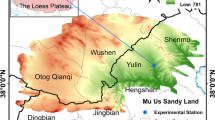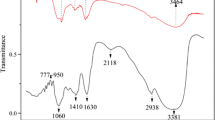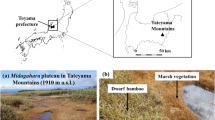Abstract
Purpose
Dissolved organic matter (DOM) is a labile and reactive fraction of soil organic matter. Ultisol usually has low content of organic matter. Fertilization is a normal way in regulating the state of soil organic matter. This study aimed to investigate the effects of different fertilizations on the content, distribution, structure, and biodegradability of DOM from Ultisol.
Materials and methods
Ultisol treated by no fertilizer (Ck), chemical fertilizer (NPK), the mixture of chemical fertilizer and straw (NPKS), and animal manure (AM) were collected from a long-term fertilization experimental site. Soil DOM was extracted by deionized water with solid to water ratio of 1:5. The concentration of dissolved organic carbon and total soluble nitrogen in DOM was determined by TOC analyzer. The structure of DOM was investigated by fluorescence spectroscopy through the emission spectra, excitation spectra, synchronous-scan spectra, and excitation-emission matrix. Soil DOM was incubated for 21 days after the addition of soil microbial inoculum and nutrient solution, the biodegradability of DOM was estimated by calculating the percentage of dissolved organic carbon lost after 21 days of incubation.
Results and discussion
The content of dissolved organic carbon in the soil of Ck, NPK, NPKS, and AM was 22.14, 27.05, 36.08, and 56.04 mg/kg, respectively. The distribution of dissolved organic carbon on large macroaggregate increased from 47.0% in Ck to 65.0–71.5% in fertilized treatments but that on small macroaggregate decreased from 35.5% in Ck to 18.3–19.9% in fertilized treatments. Similar peak wavelength and a fluorophore at wavelength pair of 330–340ex/406–422em were found in all examined DOM. However, a sequence of AM > NPKS > NPK > Ck was found in the fluorescence intensity of examined DOM, indicating the simplification of DOM structure induced by fertilization. The biodegradability of DOM from the Ck, NPK, NPKS, and AM treatment after 21 days of incubation was 23.9, 28.7, 34.2, and 42.7%, respectively.
Conclusions
Organic and inorganic fertilization increased the content of DOM from Ultisol. Compared to the Ck treatment, the fertilization treatments increased the distribution of dissolved organic carbon on large macroaggregate but reduced its distribution on small macroaggregate. Humic acid-like compounds were the dominant fractions in DOM from all treatments. DOM from Ck and NPK treatments had more complex molecular structure and lower biodegradability than that from NPKS and AM treatments.



Similar content being viewed by others
References
Bowen SR, Gregorich EG, Hopkins DW (2009) Biochemical properties and biodegradation of dissolved organic matter from soils. Biol Fertil Soils 45(7):733–742. https://doi.org/10.1007/s00374-009-0387-6
Chen W, Westerhoff P, Leenheer JA, Booksh K (2003) Fluorescence excitation-emission matrix regional integration to quantify spectra for dissolved organic matter. Environ Sci Technol 37(24):5701–5710. https://doi.org/10.1021/es034354c
Ding X, Yuan Y, Liang Y, Li L, Han X (2014) Impact of long-term application of manure, crop residue, and mineral fertilizer on organic carbon pools and crop yields in a Mollisol. J Soils Sediments 14(5):854–859. https://doi.org/10.1007/s11368-013-0840-x
Fang H, Cheng S, Yu G, Xu M, Wang Y, Li L, Dang X, Wang L, Li Y (2014) Experimental nitrogen deposition alters the quantity and quality of soil dissolved organic carbon in an alpine meadow on the Qinghai-Tibetan Plateau. Appl Soil Ecol 81:1–11. https://doi.org/10.1016/j.apsoil.2014.04.007
Fröberg M, Grip H, Tipping E, Svensson M, Strömgren M, Kleja DB (2013) Long-term effects of experimental fertilization and soil warming on dissolved organic matter leaching from a spruce forest in Northern Sweden. Geoderma 200-201:172–179. https://doi.org/10.1016/j.geoderma.2013.02.002
Gregorich EG, Beare MH, Stoklas U, St-Georges P (2003) Biodegradability of soluble organic matter in maize-cropped soils. Geoderma 113(3-4):237–252. https://doi.org/10.1016/S0016-7061(02)00363-4
He YT, Zhang WJ, Xu MG, Tong XG, Sun FX, Wang JZ, Huang SM, Zhu P, He XH (2015) Long-term combined chemical and manure fertilizations increase soil organic carbon and total nitrogen in aggregate fractions at three typical cropland soils in China. Sci Total Environ 532:635–644. https://doi.org/10.1016/j.scitotenv.2015.06.011
Huang Y, Li B, Bryant C, Bol R, Eglinton G (1999) Radiocarbon dating of aliphatic hydrocarbons: a new approach for dating passive-fraction carbon in soil horizons. Soil Sci Soc Am J 63:1181–1187
Kalbitz K, Schwesig D, Schmerwitz J, Kaiser K, Haumaier L, Glaser B, Ellerbrock R, Leinweber P (2003) Changes in properties of soil-derived dissolved organic matter induced by biodegradation. Soil Biol Biochem 35(8):1129–1142. https://doi.org/10.1016/S0038-0717(03)00165-2
Li Y, Wang S, Li Z, Zhao H, Jiao L, Zhao Y, He X (2014) Composition and spectroscopic characteristics of dissolved organic matter extracted from the sediment of Erhai Lake in China. J Soils Sediment 14(9):1599–1611. https://doi.org/10.1007/s11368-014-0916-2
LuRK (1999) Method of soil agro-chemical analysis (in Chinese). China Agricultural Science and Technology Press, Beijing
LvYZ, LiBG (2010) Soil experiment (in Chinese). China Agricultural Press, Beijing
Malik A, Gleixner G (2013) Importance of microbial soil organic matter processing in dissolved organic carbon production. FEMS Microbiol Ecol 86(1):139–148. https://doi.org/10.1111/1574-6941.12182
Marschner B, Kalbitz K (2003) Controls of bioavailability and biodegradability of dissolved organic matter in soils. Geoderma 113(3-4):211–235. https://doi.org/10.1016/S0016-7061(02)00362-2
Mcknight DM, Boyer EW, Westerhoff PK, Doran PT, Kulbe T, Andersen DT (2001) Spectrofluorometric characterization of dissolved organic matter for indication of precursor organic material and aromaticity. Limnol Oceanogr 46(1):38–48. https://doi.org/10.4319/lo.2001.46.1.0038
Ohno T, Bro R (2006) Dissolved organic matter characterization using multiway spectral decomposition of fluorescence landscapes. Soil Sci Soc Am J 70(6):2028–2037. https://doi.org/10.2136/sssaj2006.0005
Orazio V, Traversa A, Senesi N (2014) Forest soil organic carbon dynamics as affected by plant species and their corresponding litters: a fluorescence spectroscopy approach. Plant Soil 374:473–484
Qi R, Li J, Lin Z, Li Z, Li Y, Yang X, Zhang J, Zhao B (2016) Temperature effects on soil organic carbon, soil labile organic carbon fractions, and soil enzyme activities under long-term fertilization regimes. Appl Soil Ecol 102:36–45. https://doi.org/10.1016/j.apsoil.2016.02.004
Qiu S, Gao H, Zhu P, Hou Y, Zhao S, Rong X, Zhang Y, He P, Christie P, Zhou W (2016) Changes in soil carbon and nitrogen pools in a Mollisol after long-term fallow or application of chemical fertilizers, straw or manures. Soil Tillage Res 163:255–265. https://doi.org/10.1016/j.still.2016.07.002
Senesi N, Miano TM, Provenzano MR, Brunetti G (1991) Characterization, differentiation, and classification of humic substances by fluorescence spectroscopy. Soil Sci 152:248–252
Sun S, Liu J, Li Y, Jiang P, Chang SX (2013) Similar quality and quantity of dissolved organic carbon under different land use systems in two Canadian and Chinese soils. J Soils Sediments 13(1):34–42. https://doi.org/10.1007/s11368-012-0604-z
Toosi ER, Doane TA, Horwath WR (2012) Abiotic solubilization of soil organic matter, a less-seen aspect of dissolved organic matter production. Soil Biol Biochem 50:12–21. https://doi.org/10.1016/j.soilbio.2012.02.033
Traversa A, D’Orazio V, Mezzapesa GN, Bonifacio E, Farrag K, Senesi N, Brunetti G (2014) Chemical and spectroscopic characteristics of humic acids and dissolved organic matter along two Alfisol profiles. Chemosphere 111:184–194. https://doi.org/10.1016/j.chemosphere.2014.03.063
Tye AM, Lapworth DJ (2016) Characterising changes in fluorescence properties of dissolved organic matter and links to N cycling in agricultural floodplains. Agric Ecosyst Environ 221:245–257. https://doi.org/10.1016/j.agee.2016.01.033
Wei ZM, Zhao XY, Zhu CW, Xi BD, Zhao Y, Yu X (2014) Assessment of humification degree of dissolved organic matter from different composts using fluorescence spectroscopy technology. Chemosphere 95:261–267. https://doi.org/10.1016/j.chemosphere.2013.08.087
Yang W, Li Z, Cai C, Guo Z, Chen J, Wang J (2013) Mechanical properties and soil stability affected by fertilizer treatments for an Ultisol in subtropical China. Plant Soil 363(1-2):157–174. https://doi.org/10.1007/s11104-012-1266-8
Acknowledgements
We are grateful to Prof. Youjun Deng (Texas A&M University, USA) for revising the manuscript.
Funding
The research was financially supported by the Fundamental Research Funds for the Central Universities (program number: 2662017JC009) and China Agriculture Research System-Green Manure (CARS-22).
Author information
Authors and Affiliations
Corresponding author
Additional information
Responsible editor: Heike Knicker
Rights and permissions
About this article
Cite this article
Xu, P., Zhu, J., Fu, Q. et al. Structure and biodegradability of dissolved organic matter from Ultisol treated with long-term fertilizations. J Soils Sediments 18, 1865–1872 (2018). https://doi.org/10.1007/s11368-018-1944-0
Received:
Accepted:
Published:
Issue Date:
DOI: https://doi.org/10.1007/s11368-018-1944-0




